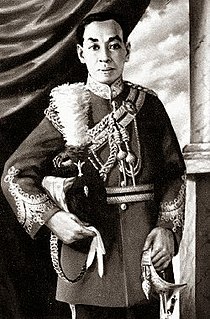
Sultan Musa Ghiatuddin Riayat Shah Ibni Al-Marhum Sultan Alauddin Sulaiman Shah was Sultan of Selangor in Malaysia during the Japanese occupation of that state (1942–1945). He received the Order of the Rising Sun from the Emperor of Japan.
The Deccan sultanates were five late-medieval Indian kingdoms—on the Deccan Plateau between the Krishna River and the Vindhya Range—that were ruled by Muslim dynasties: namely Ahmadnagar, Berar, Bidar, Bijapur, and Golconda. The sultanates had become independent during the break-up of the Bahmani Sultanate. In 1490, Ahmadnagar declared independence, followed by Bijapur and Berar in the same year. Golconda became independent in 1518, and Bidar in 1528.

Mandu or Mandavgad is an ancient city in the present-day Mandav area of the Dhar district. It is located in the Malwa region of western Madhya Pradesh, India, at 35 km from Dhar city. In the 11th century, Mandu was the sub division of the Tarangagadh or Taranga kingdom. This fortress town on a rocky outcrop about 100 km (62 mi) from Indore is celebrated for its architecture.

The Adil Shahi or Adilshahi, was a Shia Muslim dynasty, founded by Yusuf Adil Shah, that ruled the Sultanate of Bijapur, centred on present-day Bijapur district, Karnataka in India, in the Western area of the Deccan region of Southern India from 1489 to 1686. Bijapur had been a province of the Bahmani Sultanate (1347–1518), before its political decline in the last quarter of the 15th century and eventual break-up in 1518. The Bijapur Sultanate was absorbed into the Mughal Empire on 12 September 1686, after its conquest by the Emperor Aurangzeb.

Sultan Alaeddin Sulaiman Shah Ibni Al-Marhum Raja Musa was the fifth Sultan of Selangor from 1898 until 1938. He was previously known as Raja Sulaiman before being crowned Sultan.

Muhammad Adil Shah was the fourth ruler of the Sur dynasty, a late medieval Afghan dynasty of northern India.
Ibrahim Shah Suri was the fifth ruler of Sur dynasty, a Pashtun (Afghan) dynasty of late medieval northern India.
Abu Bakr was a sahabi, one of the companions of Muhammad and the first Caliph of Islam. He was also Muhammad's father-in-law through Aisha. His real name was Abdullah or Abul-Kaaba and Abu Bakr was his kunya.
Muhammad is the primary transliteration of the Arabic given name مُحَمَّد that comes from the passive participle of the Arabic verb ḥammada (حَمَّدَ), praise, which comes from the triconsonantal root Ḥ-M-D. The word can therefore be translated as "praised, commendable, laudable".

The Farooqi dynasty' was the ruling dynasty of the Khandesh sultanate from its inception in 1382 till its annexation by the Mughal emperor Akbar in 1601. The founder of the dynasty, Malik Ahmad participated in a rebellion against the Bahmani ruler Muhmmad Shah I in his early years. When he was compelled to flee from Deccan, he established in Thalner on the Tapti River. After receiving the grant of the fiefdoms of Thalner and Karanda from Firuz Shah Tughluq in 1370, he conquered the region around Thalner, which later became known as Khandesh. By 1382, he started ruling independently. Malik Raja claimed his descent from the second Caliph Umar-al-Faruq. Hence, the dynasty founded by him was known as Faruqi dynasty. The next ruler, Nasir Khan conquered the Asirgarh fort and made it his capital. He founded the new capital Burhanpur in 1399. The most illustrious ruler of this dynasty was Adil Khan II. During his long reign, Burhanpur was transformed to a major centre for trade and textile production. In 1599, Akbar’s army occupied Burhanpur and on January 17, 1601 the citadel of Asirgarh also fell after a long siege. The last ruler Bahadur Shah surrendered to the Mughals. Khandesh became a Mughal Subah.

Mohammed Adil Shah was the seventh ruler of Bijapur, ascending the throne in 1627. He is buried in the Gol Gumbaz.

On the death of Mohammed Adil Shah, Sultan of Bijapur on 4 November 1656, Ali Adil Shah II, a youth of eighteen, succeeded to the throne of Bijapur through the efforts of the Prime Minister Khan Muhammad and the Queen, Badi Sahiba, sister of Qutb Shah of Golkonda.
Muhammad Khan Sur was appointed the governor of Bengal by Sultan Islam Shah Suri of Delhi in 1545. But after the death of the Delhi Sultan in 1554, Muhammad Khan declared independence and styled himself as Shamsuddin Muhammad Shah.
Pir Hashim Dastgir is an Indian Sufi, in the traditions of Qadriya and Shattari.

The Siege of Bijapur began in March 1685 and ended in September 1686 with a Mughal victory. The siege began when the Aurangzeb dispatched his son Muhammad Azam Shah with a force of nearly 50,000 men to capture Bijapur Fort and defeat Sikandar Adil Shah, the then ruler of Bijapur who refused to be a vassal of the Mughal Empire. The Siege of Bijapur was among the longest military engagements by the Mughals, lasting more than 15 months until Aurangzeb personally arrived to organize a victory.
Events from the year 1554 in India.
Events from the year 1590 in India.
Muhammad Shah or Mohammad Shah may refer to:
Adil is an Arabic given name and surname.
This page is based on this
Wikipedia article Text is available under the
CC BY-SA 4.0 license; additional terms may apply.
Images, videos and audio are available under their respective licenses.








